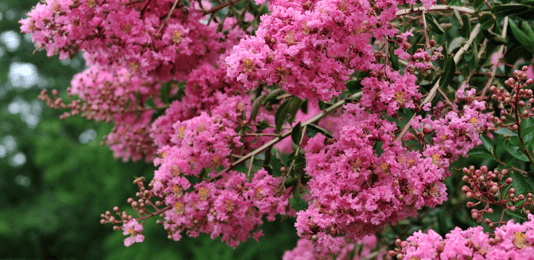
Home / Here on Earth / Crape Myrtle Pruning Guide
It is a common mistake to cut the crape myrtle to make the trunks bare with the idea of getting more flowers. However, these practices can cause delayed flowering with a shorter bloom time. The other issues associated with this pruning approach include weakening branches and increasing disease and insect problems. This process proves fatal to the trees and is the wrong way to prune a crape myrtle. Here are the best practices when it comes to maintaining your crape myrtle:
When Should you Prune?
Crape myrtle trees only bloom with new growth; hence all the pruning you want should be carried out before the start of any new growth. We know crape myrtle is among the last plants to start growing in your garden.
Some gardeners also start to prune during the fall once the leaves fall down. However, it is not a good idea for the following two reasons:
- You can see a pruned look with it that will remain all winter. It can be less appealing and less natural in the landscape.
- There are certain locations where you have to add the buffer to avoid any potential damage during the winter. It can be pruned later in February.
All the well-structured and well-established plants barely require annual pruning. A good job of pruning when the trees are young helps build the proper structure and form. These need less care and the trees grow much better as they continue to grow.
General Tips for Crape Myrtle Pruning
Some of the tips for effective pruning are as follows:
- If you find the crape myrtle having sucker growth from the base, you should prune and cut them close to the ground level.
- For the crossed and rubbing branches, you can prune if you wish. You have to cut as far back as possible while at the crossing point.
- The branches found at eye level can cause injury; you should prune them.
- If you find the branches grown and touching a building, you should prune them.
The Right Way to Prune Crape Myrtle
 The best way to prune crape myrtle is to boost the natural form instead of adding pressure on them to grow in a crowded space or artificial environment. Crape myrtles grow naturally upright or in any vase-shaped tree having several trunks. If you are able to prune the crape myrtle perfectly, the trunk gets an outward and upward growth with branches properly fanning out.
The best way to prune crape myrtle is to boost the natural form instead of adding pressure on them to grow in a crowded space or artificial environment. Crape myrtles grow naturally upright or in any vase-shaped tree having several trunks. If you are able to prune the crape myrtle perfectly, the trunk gets an outward and upward growth with branches properly fanning out.
Before you start pruning, check the following steps:
- Make sure you check the direction of the trunk and branch's growth. If you start at ground level, you must follow the trunks upward from where they start to grow the branches.
- Make sure you focus on the interior portion of the tree instead of the outer edges.
- Remove the branches that grow at the center that crosses over the trunks of braces.
There is a method of removing branches as you must follow it back from where you find it joining over the trunk or a larger branch. First, find the branch collar (the point where the two branches join). A few centimeters away from where the branches meet is where you can remove the branch by cutting it over the branch collar instead of adding the flush with the trunk.
You can cut the entire trunk by cutting it closer to the ground level. However, this will lead to profuse sprouting during the summer season. This technique should be the last option.
If the tree is small, you must first clear its interiors and remove the tiny branches growing over the main trunk. You can do this using a hand pruner. These practices help in keeping the tree look clean and tidy and, at the same time, boost the size of flower clusters.
How To Reduce Tree Size?-png.png?width=534&name=Crape%20Myrtle%20(1)-png.png)
Some crape myrtle varieties, including Tuskegee, Natchez, and Muskogee, easily reach up to 25 to 30 feet height spread. If you are planning on planting a plant that has large growth potential, it is important to keep that in mind and allow it the appropriate space to be able to grow. If you are limited in space, then consider a compact variety such as Sioux, Catawba, and Tonto that grows up to 15 feet.
If the tree is planted in too small of a space, it will most likely need to be moved at some point to a different area with more space. If you are unable to move the tree, you can plan to shorten the height and width with the help of cutting the wide-spreading branches at the point you find them joining another branch. This is called reduction pruning, which will help secure the natural shape of your tree and is preferred over options of pruning. You need more frequent pruning if you keep a wider variety limited to the small space. If you want to reduce irrigation and fertilizer applications, you can easily keep the trees in bounds.
Crape myrtle pruning can go wrong, leading to plant damage. If you feel unsure about pruning, it is always a good idea to seek professional help before accidentally damaging any plants. With professional groups like Down To Earth, the task of crape myrtle pruning becomes easy. If you want to learn more or have any questions about pruning, contact us for more information, or if you are looking for landscaping services or trusted professionals to maintain your landscape, request an estimate today!

-png.png?width=534&name=Crape%20Myrtle%20(2)-png.png)